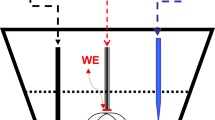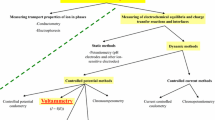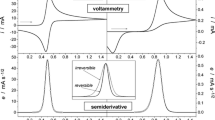Abstract
Differential pulse voltammetry has often been considered one of the most suitable techniques for electroanalytical applications. However, the voltammetric parameters used are often chosen without a proper examination of their effect on the resulting response. In this lab experiment, the students are guided to a more informed choice of the electrochemical parameters to apply depending on the application sought. In the first part of the experiment, we highlight how each voltammetric parameter affects the signal-to-noise ratio and the resolution of the voltammetric response of hydroquinone, taken as an example of the application of this electrochemical technique. A Design of Experiment is then applied to optimize the intensity and the sharpness of the oxidation peak response. Finally, an analogous approach is followed to optimize the peak resolution of an equimolar hydroquinone and catechol mixture to achieve the best separation among the peak current response for the two electrochemical processes. Thanks to these two experiments, the student will identify the correct choice of parameters to optimize as key factors for achieving the best analytical performance in specific applications.







Similar content being viewed by others
References
Molina A, González J (2016) Pulse voltammetry in physical electrochemistry and electroanalysis: theory and application. Springer, Switzerland
Scholz F (2015) Voltammetric techniques of analysis: the essentials. ChemTexts. https://doi.org/10.1007/s40828-015-0016-y
Elgrishi N, Rountree KJ, McCarthy BD, Rountree ES, Eisenhart TT, Dempsey JL (2018) A practical beginner’s guide to cyclic voltammetry. J Chem Educ. https://doi.org/10.1021/acs.jchemed.7b00361
Bard AJ, Faulkner LR (2001) Electrochemical metohds fundamentals and applications. Wiley, New York
Zhang H, Li S, Zhang F, Wang M, Lin X, Li H (2017) Simultaneous detection of hydroquinone and catechol on electrochemical-activated glassy carbon electrode by simple anodic and cathodic polarization. J Solid State Electrochem. https://doi.org/10.1007/s10008-016-3426-x
Ahammad AJS, Ullah MA, Hoque MM, Mamun MA, Alam MK, Anju AN, Mozumder MNI, Karim R, Sarker S, Kim DM et al (2017) Signal enhancement of hydroquinone and catechol on their simultaneous determination. https://doi.org/10.20964/2017.08.64
Ahammad AJS, Sarker S, Rahman MA, Lee J-J (2010) Simultaneous determination of hydroquinone and catechol at an activated glassy carbon electrode. Electroanalysis. https://doi.org/10.1002/elan.200900449
Zanardi C, Ferrari E, Pigani L, Arduini F, Seeber R (2015) Development of an electrochemical sensor for NADH determination based on a caffeic acid redox mediator supported on carbon black. Chemosensors. https://doi.org/10.3390/chemosensors3020118
Moro G, Barich H, Driesen K, Montiel NF, Neven L, Mendonça CD (2020) Unlocking the full power of electrochemical fingerprinting for on-site sensing applications. Anal Bioanal Chem. https://doi.org/10.1007/s00216-020-02584-x
Moro G, Bottari F, Sleegers N, Florea A, Cowen T, Moretto LM, Piletsky S, De Wael K (2019) Conductive imprinted polymers for the direct electrochemical detection of β-lactam antibiotics: the case of cefquinome. Sensors Actuators B Chem. https://doi.org/10.1016/j.snb.2019.126786
Ojani R, Raoof J-B, Maleki AA, Safshekan S (2014) Simultaneous and sensitive detection of dopamine and uric acid using a poly(L-methionine)/gold nanoparticle-modified glassy carbon electrode. Chinese J Catal. https://doi.org/10.1016/S1872-2067(14)60022-X
Ahmed RK, Saad EM, Fahmy HM, El Nashar RM (2022) Multivariate experimental design: towards more reliable electrochemical detection. Curr Opin Electrochem. https://doi.org/10.1016/j.coelec.2021.100880
Bello A, Giannetto M, Mori G, Seeber R, Terzi F, Zanardi C (2007) Optimization of the DPV potential waveform for determination of ascorbic acid on PEDOT-modified electrodes. Sensors Actuators B Chem. https://doi.org/10.1016/j.snb.2006.04.066
Brereton RG (2018) Experimental design. In: Chemometrics, Wiley, New York.
Acknowledgements
F.C. acknowledges the Ca’ Foscari University of Venice for the support of his work within this University as Visiting Scholar.
Author information
Authors and Affiliations
Contributions
All authors contributed to study conception and design. Material preparation, data collection, and analysis were performed by GM, AS, AU, FC, and CZ. All authors contributed in writing different sections of the manuscript, as well as to revise and approve the overall text.
Corresponding author
Ethics declarations
Competing interests
The authors declare no competing interests.
Additional information
Publisher's Note
Springer Nature remains neutral with regard to jurisdictional claims in published maps and institutional affiliations.
Supplementary Information
Below is the link to the electronic supplementary material.
Rights and permissions
Springer Nature or its licensor (e.g. a society or other partner) holds exclusive rights to this article under a publishing agreement with the author(s) or other rightsholder(s); author self-archiving of the accepted manuscript version of this article is solely governed by the terms of such publishing agreement and applicable law.
About this article
Cite this article
Moro, G., Silvestri, A., Ulrici, A. et al. How to optimize the analytical performance of differential pulse voltammetry: one variable at time versus Design of Experiments. J Solid State Electrochem 28, 1403–1415 (2024). https://doi.org/10.1007/s10008-023-05753-x
Received:
Revised:
Accepted:
Published:
Issue Date:
DOI: https://doi.org/10.1007/s10008-023-05753-x




